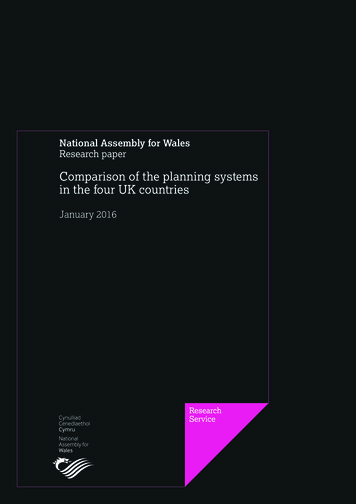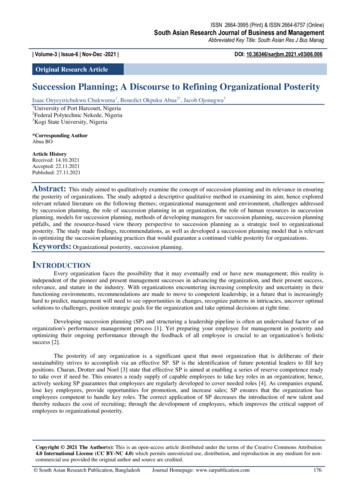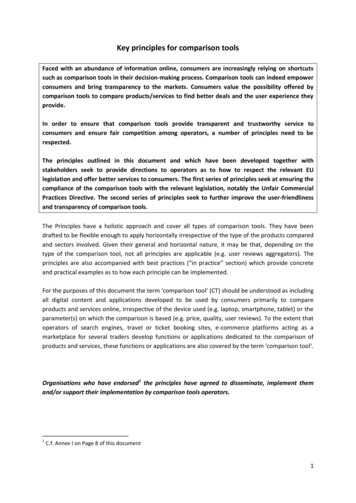
Transcription
National Assembly for WalesResearch paperComparison of the planning systemsin the four UK countriesJanuary 2016ResearchService
The National Assembly for Wales is the democraticallyelected body that represents the interests of Wales andits people, makes laws for Wales and holds the WelshGovernment to account.The Research Service provides expert and impartial research and information to supportAssembly Members and committees in fulfilling the scrutiny, legislative and representativefunctions of the National Assembly for Wales.Research Service briefings are compiled for the benefit of Assembly Members and their supportstaff. Authors are available to discuss the contents of these papers with Members and their staff butcannot advise members of the general public. We welcome comments on our briefings; please postor email to the addresses below.An electronic version of this paper can be found on the National Assembly website at:assembly.wales/researchFurther hard copies of this paper can be obtained from:Research ServiceNational Assembly for WalesCardiff BayCF99 1NAEmail: Research@assembly.walesTwitter: @SeneddResearch National Assembly for Wales Commission Copyright 2016The text of this document may be reproduced free of charge in any format or medium providingthat it is reproduced accurately and not used in a misleading or derogatory context. The materialmust be acknowledged as copyright of the National Assembly for Wales Commission and the titleof the document specified.Enquiry no: 15/02063Paper number: 16/001
National Assembly for WalesResearch paperComparison of the planning systemsin the four UK countriesJanuary 2016Graham WinterThis paper describes and compares aspects of the current land use planning systemsoperating in the four UK countries. In particular, given the changes introduced by theUK Coalition Government (2010-2015) and the devolved administrations, it compares theextent to which the four planning systems now differ from each other. It also describesfurther proposals for change that are in the pipeline. This is an update of a previous version of this paper published in June 2013.Special thanks:This paper has been prepared as an initiative of the Inter-ParliamentaryResearch and Information Network (IPRIN) with contributions fromresearch staff working for each of the four UK legislatures and is beingpublished separately by each organisation.The other contributors are:Louise Smith, House of Commons LibrarySuzie Cave, Northern Ireland Assembly Research and Information ServiceAlan Rehfisch, Scottish Parliament Information Centre
ContentsComparison of the planning systems in the four UK countries . 1The Legislative framework . 2National planning policy and guidance . 4Regional planning/strategies . 6Local Development Plans . 8Neighbourhood/community plans . 11Nationally Significant Infrastructure Projects. 13Neighbourhood development orders/Community right to build orders . 16Permitted development rights . 17Use classes . 19Planning conditions . 21Advertisement consent. 23Environmental Impact Assessments . 25Appeals/Planning Inspectorate . 27Enforcement . 29Community Infrastructure Levy/Developer contributions . 32Planning advice services. 35Future changes . 36Further information . 39
Comparison of the planning systems in the four UKcountries01.1 IntroductionThis paper describes and compares aspects of the current land use planning systems operating in thefour UK countries. In particular, given the changes introduced by the UK Coalition Government(2010-2015) and by the devolved administrations, it compares the extent to which the four planningsystems now differ from each other. It also describes further changes for each country that are in thepipeline.All four countries have a planning system that is ‘plan-led’. ‘Plan-led’ means that national and localplanning policy is set out in formal development plans which describe what developments should andshould not get planning permission, how land should be protected and seeks to ensure a balancebetween development and environmental protection in the public interest. Decisions on individualplanning applications are made on the basis of the policies in these plans, unless there are otherconsiderations that need to be taken into account. Each country also has definitions of types ofdevelopment that are permitted without the need for a planning application and defines “use classes”where change of use within a class is normally permitted. An appeal system to review decisions onapplications also operates in each country. Each country also has a system in place to enforcebreaches of planning consent.Although the basic structures of the four systems are similar there are differences in the detail and inhow each system works. Recent changes introduced by the UK Coalition Government (2010-2015)have seen a greater divergence between the system in England and the other three countries in thelast couple of years. England, Scotland, Northern Ireland and Wales now each have their own primaryplanning legislation. The system in Northern Ireland has been changed significantly recently withpassing of planning functions to local Councils. The Planning (Wales) Act 2015 received Royal Assentin July 2015, although not all of its provisions are yet in force.1
The Legislative framework02.1 EnglandIn England, the main Planning Acts currently in force are: The Town and Country Planning Act 1990 which consolidated previous town and countryplanning legislation and sets out how development is regulated. The Planning and Compulsory Purchase Act 2004 which made changes to development control,compulsory purchase and application of the Planning Acts to Crown land. The Planning Act 2008 which sets out the framework for the planning process for nationallysignificant infrastructure projects and provided for the community infrastructure levy. The Localism Act 2011 which provides the legal framework for the neighbourhood planningpowers and the duty to cooperate with neighbouring authorities.02.2 Northern IrelandInstitutional arrangements are different in Northern Ireland compared to other parts of the UK.Ministers within departments are granted full executive authority in their respective areas ofresponsibility; however, they must achieve broad agreement from the Northern Ireland Executive toensure cohesion.On the 1st April 2015 a new two-tier planning system came into force under the Planning Act(Northern Ireland) 2011 (2011 Planning Act), introducing a sharing of planning responsibilitiesbetween Councils and the Department of Environment (the Department)1. This replaced the oldsystem under the Planning (Northern Ireland) Order 1991 where the Department of Environmentheld responsibilities for planning in Northern Ireland. Under the 2011 Planning Act, each new Councilis the Local Planning Authority for its district Council area. The Councils now have responsibility forlocal development planning; development management and planning enforcement.However the Department still holds responsibility for regionally significant and 'called-in' applications;regional planning policy; planning legislation; oversight and guidance for Councils and performancemanagement.The 2011 Act is supported by a significant programme of subordinate legislation. Further details ofthis can be accessed here.02.3 ScotlandThere are two pieces of legislation that govern the operation of the Scottish planning system: The Town and Country Planning (Scotland) Act 1997 is the basis for the planning system andsets out the roles of the Scottish Ministers and local authorities with regard to development plans,development management and enforcement. This Act was substantially amended by the Planningetc. (Scotland) Act 2006.However, departmental change is expected in 2016 where regional planning could be moved to a new Department ofInfrastructure. Until such time, responsibilities will remain with the Department of Environment.12
The Planning (Listed Buildings and Conservation Areas) (Scotland) Act 1997 is mainlyconcerned with the designation and protection of listed buildings and conservation areas. This Actwas amended by the Historic Environment (Amendment) Scotland Act 2011 and the HistoricEnvironment (Scotland) Act 2014.02.4 WalesMost parts of the town and country planning system in Wales are devolved. However the primarylegislative framework is broadly the same as in England, although there are some differences in bothprimary and related subordinate legislation as it applies to Wales. The Planning (Wales) Act 2015 thatreceived Royal Assent in July 2015, once fully in force, will introduce further differences. The systemcurrently operates at two levels: Nationally: through the Welsh Government and the Planning Inspectorate; and Locally: through Local Planning Authorities.A third ‘regional’ tier could be introduced by the 2015 Act. Parts of Wales may be identified asStrategic Planning Areas and for these areas Strategic Planning Panels will be established (see section4 below). The principal legislative framework for the planning system in Wales is now provided by the: Town and Country Planning Act 1990; Planning and Compulsory Purchase Act 2004; and Planning Act 2008; Planning (Wales) Act 2015The majority of executive functions and secondary legislative powers contained in the first two actswere transferred to the National Assembly for Wales by the National Assembly for Wales (Transferof Functions) Order 1999. These powers have subsequently been transferred to Welsh Ministers asa result of the Government of Wales Act 2006. Since 2011 the Assembly has had competence to pass Acts in the general area of Town andCountry Planning. The Planning (Wales) Act 2015 is the first such Act.3
National planning policy and guidance03.1 EnglandThe National Planning Policy Framework (NPPF) published in March 2012 sets out the UKGovernment’s planning policies for England and how it expects these to be applied. The NPPF mustbe taken into account in the preparation of local plans and is a material consideration in planningdecisions. Three further documents should be read in conjunction with the NPPF:Planning policy for traveller sites, updated August 2015;Technical Guidance to the National Planning Policy Framework, March 2012, provides additionalguidance to local authorities on development in areas at risk of flooding and in relation to mineralextraction; andNational Planning Policy for Waste, October 2014.In March 2014 the Government launched its online Planning Practice Guidance (PPG) which isdesigned to accompany the NPPF. It is the Secretary of State’s view on how the NPPF’s policiesshould be used in practice and to provide further information. The PPG is actively managed by theDepartment for Communities and Local Government and is frequently updated.There are no specific policies for nationally significant infrastructure projects in the NPPF or PPG. TheSecretary of State determines these in accordance with the Planning Act 2008 and relevant nationalpolicy statements for major infrastructure, which cover the fields of energy, transport, water, wastewater and waste.03.2 Northern IrelandUnder the Programme for Government (PfG), the Northern Ireland Executive maps out goals forNorthern Ireland in terms of planning and development with reference to sustainable development.This is carried forward by the departments that have responsibility for developing policy andlegislation.Generally the development of planning policy and guidance in Northern Ireland is the responsibility ofthe Department and operates on a single regional (ie: Northern Ireland) basis. However, RegionalStrategic Planning and development policy is the responsibility of the Department of RegionalDevelopment (DRD) in the form of the Regional Development Strategy 2035 (RDS).The RDS, produced by the DRD, offers a strategic and long-term perspective on the futuredevelopment of Northern Ireland up to 2035. Its purpose is to deliver the spatial aspects of the PfGand is therefore a framework for regional planning across Northern Ireland. The 2011 Planning Actrequires the Department to ensure that any policy it produces is “in general conformity” with the RDSThe new planning system involves the move away from the existing suite of Planning PolicyStatements (PPS) to a single Strategic Planning Policy Statement (SPPS). The SPPS consolidatesthe suite of PPS into one document and provides the overarching planning principles from whichCouncils should develop their own planning policies within their new Local Development Plans (LDPs).It will also be material to individual planning decisions and appeals.However, a transitional period is currently in operation until Councils develop their own planningpolicies under their LDPs (see section 5.2). This means that during this time the new Councils will4
apply the policy of some of the old PPS together with the new SPPS when determining planningdecisions. However, where there is difference between the two, the SPPS takes precedence. OnceCouncils have developed and published their own policies, the old PPS will cease to have effect. Formore detail on the transition period, refer to the SPPS.03.3 ScotlandThe Scottish Government sets out the purpose of the Scottish planning system and its specific landuse policies in the Scottish Planning Policy. Spatial aspects of Scottish Government policies are setout in the National Planning Framework for Scotland 3. Updated versions of both thesedocuments were published in June 2014. More detailed subject specific advice and guidance is setout in a series of Planning Advice Notes, Planning Circulars, Guides and Letters from the ChiefPlanner.03.4 WalesPlanning Policy Wales (PPW) was originally published by the Welsh Government in 2002 and sets thecontext for planning in Wales, under which Local Planning Authorities prepare their statutoryDevelopment Plans. It is the principal and authoritative source of national planning policy.Updates to national planning policy are issued for consultation and then incorporated into the latestversion of PPW. Planning Policy Wales (Edition 7) is the latest version of PPW, issued as an onlinedocument only, in July 2014.Minerals Planning Policy Wales provides the equivalent planning policy framework for mineralextraction and related development.Technical Advice Notes (TANs) contain detailed guidance in specific areas. There is an equivalentseries for minerals, known as Minerals Technical Advice Notes (MTANs). There are currently 22topic based TANs and two MTANs.The Planning (Wales) Act 2015 will introduce a new National Development Framework (NDF) thatwill set out national spatial planning policies. The NDF replaces the Wales Spatial Plan and will formpart of the formal ‘development plan’ for Wales and development plans prepared by other bodies(Strategic and Local) must take the NDF into account. The NDF will also be used to designateDevelopments of National Significance (see Section 7 below).5
Regional planning/strategies04.1 EnglandThe former UK Coalition Government revoked the former regional spatial strategies, except for a fewindividual policies from certain regional spatial strategies which remain. Further details about whatremains for each strategy is published in a “Post Adoption Statement” for each region.In Greater London the Mayor’s London Plan remains and continues to provide the strategic contextfor issues that affect London as a whole.The UK Government introduced a “duty to cooperate” with neighbouring authorities to replaceformal regional planning. This means that public bodies have a duty to cooperate on planning issuesthat cross administrative boundaries, particularly those which relate to the strategic priorities set outin the NPPF. This duty must be reflected in any Local Plan.Section 28 of the Planning and Compulsory Purchase Act 2004 allows local authorities to prepare oneor more joint local development documents.04.2 Northern IrelandSee Section 3.2 above.04.3 ScotlandStrategic Development Plans (SDPs) set out a vision for the long term development of Scotland’s fourmain city regions (these are regions centred on Aberdeen, Dundee, Edinburgh and Glasgow), focusingon issues such as land for housing, major business and retail developments, infrastructure provisionand green belts/networks.SDPs are drafted by Strategic Development Planning Authorities (SDPAs), the membership of which isdefined in statutory designation orders. Each SDPA is under a statutory duty to publish and thenupdate its SDP at least once every five years. SDPAs are required to publish and update adevelopment plan scheme which outlines their programme for preparing and reviewing the SDP andfor engaging the public. The scheme must also contain a participation statement setting out theways in which local people and other stakeholders will be involved in the preparation of the plan.Each SDP must be accompanied by an action programme, which must be updated at least once everytwo years.The process for developing and examining a SDP is very similar to that explained in Section 5.3 onLocal Development Plans below. The key difference is that Scottish Ministers have the final say onmodification, adoption or rejection of an SDP.6
04.4 WalesThere is no statutory regional planning in Wales at present. However the Planning (Wales) Act 2015includes powers for the Welsh Government to identify Strategic Planning Areas (SPAs) that are largerthan individual Local Planning Authorities and for Strategic Planning Panels to be established forthese areas. These panels will comprise elected members from the constituent Local PlanningAuthorities. A panel, if established for an area, will then produce a Strategic Development Plan (SDP)that will form part of the formal “development plan” for that area. A SDP will cover ‘cross-border’issues such as housing and transport. A SDP will also need to take account of the NDF (see section 3above). Local Planning Authorities in a SPA must then have regard to the SDP when developing theirLocal Development Plans. The Welsh Government has indicated that there may be a need for nomore than three SPAs, and these would only cover parts of Wales. The current Welsh Government hasalso announced proposals to reduce the current number of local authorities in Wales from 22 toonly 8 or 9. If this proceeds, the need for SPAs will be less.7
Local Development Plans05.1 EnglandThe NPPF (see Section 3) directs that each Local Planning Authority should produce a Local Plan forits area.2 There is no legal requirement however, that a Local Plan must be produced.According to the NPPF Local Plans should be aspirational but realistic. They should set out thestrategic priorities for the area and be drawn up over an “appropriate” time scale, normally a 15 yearhorizon. The Local Plan should be based on adequate, up-to-date and relevant evidence about theeconomic, social and environmental characteristics and prospects of the area.The Local Plan will be examined by an independent inspector whose role is to assess whether the planhas been prepared in accordance with the duty to co-operate and other legal requirements. TheSecretary of State has powers, under Section 21 of the Planning and Compulsory Purchase Act2004, to modify a Local Plan at any time before it is officially adopted, if he/she believes that it is“unsatisfactory”. The Secretary of State can also direct that any plan is submitted for approval.Local Plans can be reviewed in whole or in part to respond flexibly to changing circumstances, but ifthis happens, must be open again to public consultation and examination if a material change is to bemade.The NPPF directs that decision-takers can also give weight to relevant policies in emerging plansaccording to: the stage of preparation of the emerging plan (the more advanced the preparation, the greater theweight that may be given); the extent to which there are unresolved objections to relevant policies (the less significant theunresolved objections, the greater the weight that may be given); and the degree of consistency of the relevant policies in the emerging plan to the policies in thisFramework (the closer the policies in the emerging plan to the policies in the Framework, thegreater the weight that may be given).In a written statement to Parliament on 21 July 2015 the UK Government said that “in cases whereno local plan has been produced by early 2017—five years after the publication of the NPPF—we willintervene to arrange for the plan to be written, in consultation with local people, to accelerateproduction of a local plan.”3 Provision to allow for this change and other additional intervention in thelocal plan making process by the Secretary of State is now contained in the Housing and PlanningBill 2015-16.For further information see the section on Plan Making in England in the National Planning PolicyFramework.In England Local Planning Authorities are District Councils, London Borough Councils, County Councils, BroadsAuthorities, National Park Authorities and the Greater London Authority2321 July 20158HCWS166
05.2 Northern IrelandThe Planning (Northern Ireland) Act 2011 establishes a new system of local development planningin Northern Ireland. Under the new system local Councils are responsible for the development ofLocal Development Plans (LDPs) rather than the Department. The new system defines developmentplans as LDPs and these must be based on consultation with the local community.The Planning (Local Development Plan) Regulations (Northern Ireland) 2015 set out in moredetail that LDPs should provide a 15 year framework on how the Council area should look in thefuture by deciding what type and scale of development should be encouraged and where it should belocated. During its preparation the Council must take into account the newly developed SPPS andalso deliver the spatial elements of a Council’s community plan.The LDP will be made up of two documents: the plan strategy and the local policies plan. Under thisnew plan-led system, the LDP will be the primary consideration in the determination of applications.Under the LDP process, the Department will have an oversight and scrutiny role to ensure the plan isin line with central government plans, policies and guidance. The local community will also have animportant role to play in the plan preparation process. A Council’s Statement of CommunityInvolvement (SCI) will set out the key stages for public engagement and inform the community ofhow and when they can become involved.Until the new local Councils develop their own LDPs, the existing development plans made by theDepartment under the old system will remain in place.For more information refer to Development Plan Practice Notes produced by the Department05.3 ScotlandLocal Development Plans (LDPs) cover the whole of Scotland and identify sites for new developmentsand set out policies that guide decision making on planning applications. Each Planning Authority4 isrequired to publish and then update Local Development Plan(s) covering their area at least onceevery five years.In addition planning authorities must publish, and update, a development plan scheme which outlinesits programme for preparing and reviewing LDPs and for engaging the public. The scheme must alsocontain a participation statement setting out the ways in which local people and other stakeholderswill be involved in the preparation of the plan.Prior to producing a LDP, a Planning Authority must first produce a main issues report, which sets outthe authority’s general proposals for development of its area and particular proposals as to wheredevelopment should and should not occur. A main issues report must also contain one or morereasonable alternative sets of proposals. Finally, it must draw attention to the ways in which thefavoured and alternative proposals differ from the spatial strategy of the existing adopted LDP (if any).The main issues report is then subject to a period of public consultation.Having had regard to the representations received to the main issues report, a Planning Authoritymust publish a proposed plan, which is subject to a minimum of six weeks public consultation.Following the close of public consultation, the Planning Authority may modify the plan in response torepresentations received. The plan will then be submitted to Scottish Ministers, along with the4In Scotland the Planning Authorities are local Councils and the National Park Authorities9
proposed action programme. If there are any unresolved representations then Scottish Ministers willappoint a Reporter to examine the proposed plan. The reporter will conduct an examination andproduce a report with recommendations for the Planning Authority. A Reporter’s recommendationsare generally binding on the Planning Authority. The authority must then modify and re-publish theplan, publicise its intention to adopt the plan and submit it to Scottish Ministers. The PlanningAuthority can adopt the plan after 28 days, unless directed not to by Scottish Ministers.Each LDP must be accompanied by an action programme that must be updated at least once everytwo years.05.4 WalesThe Planning and Compulsory Purchase Act 2004 introduced a statutory requirement for each ofthe 25 Local Planning Authorities5 to produce a Local Development Plan (LDP). The LDP sets outproposals and policies for the future use of all local land, and along with the NDF and the SDP, is theformal “development plan” in Wales. The LDP covers a period of ten to fifteen years and shouldreflect national planning policy in Wales and should also have regard to the NDF when it has beenproduced and also the SDP, if there is one (see sections 3 and 4 above). Once a SDP is in place, inthese areas the Local Planning Authority will only be required to produce a ‘light’ version of an LDP forits area in future.The Local Planning Authority prepares a deposit plan, which is a full draft of the LDP. This planrepresents the preferred strategy for the area. The Planning Inspectorate (on behalf of the WelshGovernment) then examines the deposit plan and other related documents. The aim of the publicexamination is to ensure that the plan is ‘sound’, and that the views of all those who have commentedhave been considered.The inspector publishes a report outlining any changes that should be made to the plan, with anexplanation of why these changes are needed. The views of the inspector are binding on the LocalPlanning Authority.The Welsh Ministers have wide-ranging powers in relation to LDPs including; to call-in a plan for theWelsh Government’s determination; to direct an authority not to adopt the plan where therecommendations of the inspector are considered to be in conflict with national policy and to directthat a plan shall be altered or replaced. It can also direct two or more authorities to work together toproduce a joint LDP.5In Wales the Local Planning Authorities are the 22 Unitary Authorities and the three National Park Authorities.10
Neighbourhood/community plans06.1 EnglandUnder powers provided by the Localism Act 2011 neighbourhood forums and parish Councils canestablish general planning policies for the development and use of land in a neighbourhood. Theseare called Neighbourhood Development Plans. Local Planning Authorities continue to produce LocalPlans that set the strategic context within which Neighbourhood Development Plans sit. Policiesproduced in a Neighbourhood Development Plan cannot block development that is already part ofthe local plan. What they can do, is shape and influence where that development will go and what itwill look like.Neighbourhood Development Plans do not take effect unless there is a majority of support in areferendum of the neighbourhood. They also have to meet a number of conditions to ensure plansare legally compliant and take account of wider policy considerations (e.g. national policy). Theconditions are: they must have regard to national planning policy; they must be in general conformity with strategic policies in the development plan for the localarea (i.e. such as in a core strategy); and they must be compatible with EU obligations and human rights requirements.If proposals pass the referendum, the Local Planning Authority is under a legal duty to bring theneighbourhood plan into force. Once it is in force, it becomes part of the legal framework andplanning decisions for the area must be taken in accord
1 Comparison of the planning systems in the four UK countries 01.1 Introduction This paper describes and compares aspects of the current land use planning systems operating in the










